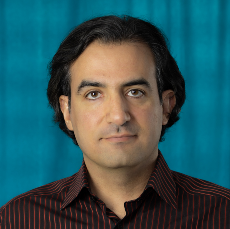
Vahid S. Bokharaie, PhD

Senior Research Scientist
Max Planck Institute for Biological Cybernetics
Tübingen, Germany
vahid DOT bokharaie AT tuebingen DOT mpg DOT de
I am an applied mathematician, a neuroscientist, and a control engineer.
Below, you can see a list of my research interests and a brief description of
each. For some, you can find more detailed information if you follow the
provided link.
Why is it that AI, in certain application areas, still hugely lags behind human performance? As a famous example, why do self-driving cars still underperform and the goals that engineers and scientists thought are easily achievable a few years ago still seem to be far away? The answer is not unknown. There are still a lot of aspects of the brain function that we do not fully know, hence trying to imitate human brain performance in engineering applications fail. In two different sets of projects, one focusing on the role of Locus Coeruleus Noradrenergic (LCNE) activity in mammals and the other studying the human gaze behavior in response to complex visual stimuli, I have discovered some new aspects of the brain function that can qualitatively enhance the performance of AI algorithm, in particular in autonomous vehicles.
Check here for more details.
How do mammals react to the changes in the environment? What role does ’attention’ play in shaping that response? In a set of experiments, we have studied how animals react to changes in the ’reward signal’. In particular, we are interested in discovering the role that Locus Coeruleus Noradrenergic (LCNE) activity plays in regulating the arousal state of the animals when a change in their environment occurs. Based on previous electrophysiology experiments that have shown a correlation between the pupil diameter and the LCNE activity, we use pupillometry and also EEG data to discover how the brain modulates its activity in response to such changes in the environment.
Check here for more details.
In a set of experiments involving simultaneous eye-tracking and EEG recordings, we studied the human gaze behavior and the corresponding changes in brain activity when the participant was exposed to complex visual stimuli. The stimuli included real-world still images, video stimuli, and also Adelson-Movshon grid which can evoke tri-stable perception in humans.
Check here for more details.
I have analyzed various biomedical imagine data, and given the specific needs of each application, usually needed to develop an in-house analysis tool. They included PET scan data, fMRI data, Electrophysiology, Electroencephalography (EEG), and Eye-tracking data. Some of the analysis tools became so comprehensive that I decided to publish them as open-source packages, or plan to do so in near future. For example, MiTfAT which is an open-source python package to analyze molecular fMRI data, which was developed as part of a collaboration that led to this PNAS publication.
I have also developed other software packages that plan to release in near future. MiTABLE is a python library for Adaptive Behavioural Learning Experiments. MiTgaze is a Python library for analyzing gaze behaviour data. And MiTARES which is a Repository to Analyse EEG signals. In MiTARES, I have implemented a method I call Spectral Signatures Clustering for reasons that should be obvious when you see what is the method doing.
You can find more details on Spectral Signatures Clustering in this page.
I was part of a team that performed a metadata analysis on neurotransmitter responses to clinically approved and experimental drugs. It led to this publication in Nature Communications. I was also part of a community effort to classify cell types in the central nervous system. Our collaboration led to this report in Nature Neuroscience.
At the onset of the COVID-19 pandemic, I used some of the mathematical models I developed in the past to develop a model to simulate the spread of SARS-CoV-2 virus in any human population with a known age-structure. It led to this PLOS ONE publication and this open-source software package.
Check here for more details.
Last updated on March 9, 2022. Generated using htlatex.